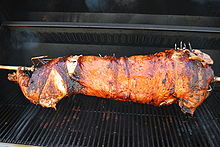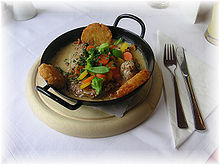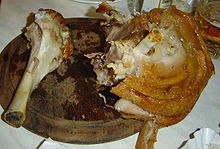- Pork
-
For other uses, see Pork (disambiguation).Slow-roasting pig on a rotisserie

Pork is the culinary name for meat from the domestic pig (Sus domesticus), which is eaten in many countries. It is one of the most commonly consumed meats worldwide,[1] with evidence of pig husbandry dating back to 5000 BC.
Pork is eaten in several forms, including cooked. Pork can also be processed into different forms, which may also extend the shelf-life of the product, with the resultant products being cured (some hams, including the Italian prosciutto) or smoked or a combination of these methods (other hams, gammon, bacon or pancetta). It is also a common ingredient in sausages. Charcuterie is the branch of cooking devoted to prepared meat products, many from pork. However, by some definitions, "pork" denotes only fresh pig meat.[citation needed]
Pork is a taboo food item in Islam and Judaism.
Contents
History
See also: CharcuterieThe pig is one of the oldest forms of livestock, having been domesticated as early as 5000 BC.[2] It is believed to have been domesticated either in the Near East or in China from the wild boar. The adaptable nature and omnivorous diet of this creature allowed early humans to domesticate it much earlier than many other forms of livestock, such as cattle. Pigs were mostly used for food, but people also used their hides for shields and shoes, their bones for tools and weapons, and their bristles for brushes. Pigs have other roles within the human economy: their feeding behaviour in searching for roots churns up the ground and makes it easier to plough; their sensitive noses lead them to truffles, an underground fungus highly valued by humans; and their omnivorous nature enables them to eat human rubbish, keeping settlements cleaner.
Charcuterie is the branch of cooking devoted to prepared meat products such as bacon, ham, sausage, terrines, galantines, pâtés, and confit, primarily from pork.[3] Originally intended as a way to preserve meats before the advent of refrigeration, these preparations are prepared today for their flavours that are derived from the preservation processes.[4] In 15th century France, local guilds regulated tradesman in the food production industry in each city. The guilds that produced charcuterie were those of the charcutiers. The members of this guild produced a traditional range of cooked or salted and dried meats, which varied, sometimes distinctively, from region to region. The only "raw" meat the charcutiers were allowed to sell was unrendered lard. The charcutier prepared numerous items, including pâtés, rillettes, sausages, bacon, trotters, and head cheese.
Before the mass production and re-engineering of pork in the 20th century, pork in Europe and North America was traditionally an autumn dish — pigs and other livestock coming to the slaughter in the autumn after growing in the spring and fattening during the summer. Due to the seasonal nature of the meat in Western culinary history, apples (harvested in late summer and autumn) have been a staple pairing to fresh pork. The year-round availability of meat and fruits has not diminished the popularity of this combination on Western plates.[5]
Consumption patterns
Pork is one of the most widely eaten meats in the world, accounting for about 38% of meat production worldwide, although consumption varies widely from place to place.[1]
According to the USDA's Foreign Agricultural Service, nearly 100 million metric tons of pork were consumed worldwide in 2006 (preliminary data). Increasing urbanization and disposable income has led to a rapid rise in pork consumption in China, where 2006 consumption was 20% higher than in 2002, and a further 5% increase projected in 2007.[6]
2006 worldwide pork consumption
Rank Region Metric tons (millions) Per capita (kg) 1 People's Republic of China 52.5 40.0 2 EU25 20.1 43.9 3 United States 9.0 29.0 4 Russian Federation 2.6 18.1 5 Japan 2.5 19.8 Others 12.2 N/A Total 98.9 N/A Source: USDA Foreign Agricultural Service, preliminary data for 2006.[6] Asian pork consumption
Pork is popular throughout eastern Asia and the Pacific, where whole roast pig is a popular item in Pacific Island cuisine. It is consumed in a great many ways and highly esteemed in Chinese cuisine.[7] There, pork is preferred over beef for economic and aesthetic reasons; the pig is easy to feed and is not used for labour. The colours of the meat and the fat of pork are regarded as more appetizing, while the taste and smell are described as sweeter and cleaner. It is also considered easier to digest.[8]
Pork products
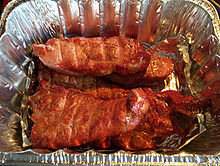 Smoked pork ribs
Smoked pork ribs
Pork may be cooked from fresh meat or cured over time. Cured meat products include ham and bacon. The carcass may be used in many different ways for fresh meat cuts, with the popularity of certain cuts and certain carcass proportions varying worldwide.
Fresh meat
Most of the carcass can be used to produce fresh meat and in the case of a suckling pig, the whole body of a young pig ranging in age from two to six weeks is roasted.
Processed pork
Pork is particularly common as an ingredient in sausages. Many traditional European sausages are made with pork, including chorizo, fuet, Cumberland sausage and salami. Many brands of American hot dogs and most breakfast sausages are made from pork.
Ham and bacon are made from fresh pork by curing with salt (pickling) and/or smoking. Shoulders and legs are most commonly cured in this manner for Picnic shoulder and ham, whereas streaky and round bacon come from the side (round from the loin and streaky from the belly).[9]
Ham and bacon are popular foods in the west, and their consumption has increased with industrialisation. Non-western cuisines also use preserved meat products. For example, salted preserved pork or red roasted pork is used in Chinese and Asian cuisine.
Bacon is defined as any of certain cuts of meat taken from the sides, belly or back that have been cured and/or smoked. In continental Europe, it is used primarily in cubes (lardons) as a cooking ingredient valued both as a source of fat and for its flavour. In Italy, besides being used in cooking, bacon (pancetta) is also served uncooked and thinly sliced as part of an antipasto. Bacon is also used for barding roasts, especially game birds. Bacon is often smoked, using various types of wood, a process which can take up to ten hours. Bacon may be eaten fried, baked, or grilled.
A side of unsliced bacon is a "flitch" or "slab bacon", while an individual slice of bacon is a "rasher" (United Kingdom, Republic of Ireland, Australia and New Zealand) or simply a "slice" or "strip" (North America). Slices of bacon are also known as "collops". Traditionally, the skin is left on the cut and is known as "bacon rind". Rindless bacon, however, is quite common. In the United Kingdom and Republic of Ireland, bacon comes in a wide variety of cuts and flavours, and is predominantly known as "streaky bacon", or "streaky rashers". Bacon made from the meat on the back of the pig is referred to as "back bacon" and is part of traditional full breakfast commonly eaten in Britain and Ireland. In the United States, back bacon may also be referred to as "Canadian-style Bacon" or "Canadian Bacon".[10]
The USDA defines bacon as "the cured belly of a swine carcass", while other cuts and characteristics must be separately qualified (e.g. "smoked pork loin bacon").[11] "USDA Certified" bacon means that it has been treated for Trichinella.
The canned meat Spam is made of chopped pork shoulder meat and ham.
Cuts
There are different systems of naming for cuts in America, Britain and France.
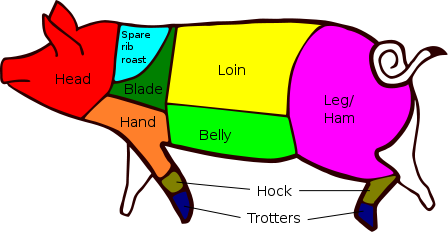 British cuts of pork
British cuts of pork American cuts of pork
American cuts of pork- Head - This can be used to make brawn, stocks and soups. After boiling, the ears can be fried or baked and eaten separately.
- Spare rib roast/spare rib joint/blade shoulder/shoulder butt[10] - This is the shoulder and contains the shoulder blade. It can be boned out and rolled up as a roasting joint, or cured as "collar bacon". It is not to be confused with the rack of spare ribs from the front belly. Pork butt, despite its name, is from the upper part of the shoulder. The Boston butt, or Boston-style shoulder, cut comes from this area, and may contain the shoulder blade.
- Hand/arm shoulder/arm picnic[10] - This can be cured on the bone to make a ham-like product, or used in sausages.
- Loin - This can be cured to give back bacon or Canadian-style bacon. The loin and belly can be cured together to give a side of bacon. The loin can also be divided up into roasts (blade loin roasts, centre loin roasts, and sirloin roasts come from the front, centre, or rear of the loin), back ribs (also called baby back ribs, or riblets), pork cutlets, and pork chops. A pork loin crown roast is arranged into a circle, either boneless or with rib bones protruding upward as points in a crown. Pork tenderloin, removed from the loin, should be practically free of fat.
- Fatback - The subcutaneous fat and skin on the back are used to make pork rinds, a variety of cured "meats", lardons, and lard.
- Belly/side/side pork - The belly, although a fattier meat, can be used for steaks or diced stir-fry meat. Belly pork may be rolled for roasting or cut for streaky bacon.
- Legs/hams - Although any cut of pork can be cured, technically speaking only the back leg is entitled to be called a ham. Legs and shoulders, when used fresh, are usually cut bone-in for roasting, or leg steaks can be cut from the bone. Three common cuts of the leg include the rump (upper portion), centre, and shank (lower portion).
- Trotters - Both the front and hind trotters can be cooked and eaten, as can the tail.[12]
- Spare ribs, or spareribs, are taken from the pig's ribs and the meat surrounding the bones. St. Louis-style spareribs have the sternum, cartilage, and skirt meat removed.
- Knuckles, intestines, jowls and all other parts of the pig may also be eaten.
Feijoada, the national dish of Brazil (also served in Portugal), is prepared with pork trimmings: ears, tail and feet.[13]
Nutrition
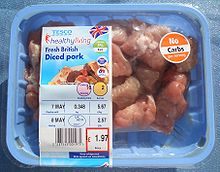 A pack of Tesco diced pork.
A pack of Tesco diced pork.
Pork, fresh, loin, whole,
separable lean and fat,
cooked, broiledNutritional value per 100 g (3.5 oz) Energy 1,013 kJ (242 kcal) Carbohydrates 0.00 g - Sugars 0.00 g - Dietary fibre 0.0 g Fat 13.92 g - saturated 5.230 g - monounsaturated 6.190 g - polyunsaturated 1.200 g Protein 27.32 g - Tryptophan 0.338 g - Threonine 1.234 g - Isoleucine 1.260 g - Leucine 2.177 g - Lysine 2.446 g - Methionine 0.712 g - Cystine 0.344 g - Phenylalanine 1.086 g - Tyrosine 0.936 g - Valine 1.473 g - Arginine 1.723 g - Histidine 1.067 g - Alanine 1.603 g - Aspartic acid 2.512 g - Glutamic acid 4.215 g - Glycine 1.409 g - Proline 1.158 g - Serine 1.128 g Water 57.87 g Vitamin A equiv. 2 μg (0%) Vitamin B6 0.464 mg (36%) Vitamin B12 0.70 μg (29%) Vitamin C 0.6 mg (1%) Vitamin K 0.0 μg (0%) Calcium 19 mg (2%) Iron 0.87 mg (7%) Magnesium 28 mg (8%) Phosphorus 246 mg (35%) Potassium 423 mg (9%) Sodium 62 mg (4%) Zinc 2.39 mg (25%) Percentages are relative to US recommendations for adults.
Source: USDA Nutrient DatabaseIts myoglobin content is lower than that of beef, but much higher than that of chicken. The USDA treats pork as a red meat.[14] Pork is very high in thiamin (vitamin B1).[15] Pork with its fat trimmed is leaner than the meat of most domesticated animals, but is still high in cholesterol and saturated fat.
In 1987 the U.S. National Pork Board began an advertising campaign to position pork as "the other white meat" — due to a public perception of chicken and turkey (white meat) as healthier than red meat. The campaign was highly successful and resulted in 87% of consumers identifying pork with the slogan. The board retired the slogan on March 4, 2011.[16]
Undercooked or untreated pork may harbour pathogens, or it can be recontaminated after cooking. In one instance, the FSIS detected Listeria monocytogenes in 460 lbs of Polidori brand fully cooked pork sausage crumbles.[17] The FSIS has previously stated Listeria and other microorganisms will be "destroyed by proper handling and thorough cooking to an internal temperature of 160 °F (71 °C)" and that other microorganisms, such as E. coli, Salmonella, and Staphylococcus aureus can be found in inadequately cooked pork, poultry, and other meats.[18] The FSIS currently recommends cooking ground pork to 160 °F (71 °C) and whole cuts to 145 °F (63 °C) followed by a 3 minute rest.[19]
The pig is the carrier of various helminths, such as roundworms, pinworms, hookworms, etc. One of the most dangerous and common is Taenia solium, a type of tapeworm. Tapeworms may transplant to the intestines of humans, as well, when they consume untreated or undercooked meat from pigs or other animals. If the infection is not treated, it can be fatal.
Although not a common cause of illness, Yersinia enterocolitica – which causes gastroenteritis – is present in various foods, but is most frequently caused by eating pork and can grow in refrigerated conditions. The bacteria can be killed by heat.[20] Nearly all outbreaks in the US have been traced to pork.[21]
Pork may be the reservoir responsible for sporadic, locally acquired cases of acute hepatitis E (HEV) reported in regions with relatively mild climates. It has been found to transmit between swine and humans.[22]
 Vacuum packed pork loin fillets
Vacuum packed pork loin fillets
Trichinosis, also called trichinellosis, or trichiniasis, is a parasitic disease caused by eating raw or undercooked pork infected with the larvae of a species of roundworm Trichinella spiralis, commonly called the trichina worm. Infection was once very common, but is now rare in the developed world. From 2002 to 2007, an annual average of 11 cases per year were reported in the United States; the majority were from consuming wild game or the source was unknown. The number of cases has decreased because of legislation prohibiting the feeding of raw meat garbage to hogs, increased commercial and home freezing of pork, and the public awareness of the danger of eating raw or undercooked pork or wild game products.[23]
Religious restrictions on the consumption of pork
Main article: Religious restrictions on the consumption of porkJudaism
Pig's meat, including pork, is one of the most well known examples of non kosher food. This prohibition is based on Leviticus chapter 11 and Deuteronomy chapter 14:
Leviticus 11:2-4, 7-8
- "These are the creatures that you may eat from among all the animals that are upon the land. Everything that possesses a split hoof, which is fully cloven, and that brings up its cud -- this you may eat. But this is what you shall not eat from what brings up its cud or possesses split hooves - the camel, because it brings up its cud but does not possess split hooves...and the pig, because it has split hooves that are completely cloven, but it does not bring up its cud -- it is impure to you and from its flesh you may not eat."
Deuteronomy 14:8
- "And the pig, because it possesses split hooves and does not bring up its cud -- from its flesh you may not eat."
As indicated by the biblical verses, Jews may not consume any land animal that does not possess both traits.
- The animal must possess completely split hooves;
- The animal must bring up its cud.
Islam
Pork is prohibited by the Islamic dietary laws. Throughout the Islamic world many countries severely restrict the importation or consumption of pork products. Examples are Iran,[24] Mauritania,[25] Oman,[26] Qatar,[27] Saudi Arabia, Kuwait, Pakistan and Maldives[28] (though conversely, the pig is the most widely reared livestock in Muslim-majority Malaysia). The Qur'anic basis for the Islamic prohibition of pork can be found in suras 2:173, 5:3, 5:60, 6:145 and 16:115.
Chapter (Sura) 2 - Verse (Ayat) 173 Al-Baqara (The Cow)
"He has forbidden you only the Maitah (dead animals), and blood, and the flesh of swine, and that which is slaughtered as a sacrifice for others than God (or has been slaughtered for idols). But if one is forced by necessity, without wilful disobedience, nor transgressing due limits, then there is no sin on him. Truly, God is Oft-forgiving Most Merciful."
Other religions and cultures
Seventh-day Adventists,[29] Rastafarians, and members of the Ethiopian Orthodox church also do not eat pork. Scottish pork taboo was Donald Alexander Mackenzie's phrase for discussing an aversion to pork amongst Scots, particularly Highlanders, which he believed stemmed from an ancient taboo. Several writers who confirm that there was a prejudice against pork, or a superstitious attitude toward pigs, do not see it in terms of a taboo related to an ancient cult. Any prejudice is generally agreed to have disappeared by 1800.
Pork meat and cannibalism
During an interview in 2007, the notorious German cannibal Armin Meiwes said, "The flesh tastes like pork, a little bit more bitter, stronger. It tastes quite good."[30]
About 3% of piglet mortality is related to cannibalism.[31] This brings up the danger of prion development when eating pork. This chance already is slightly increased because of the high tissue similarity of pork and human.[32][33]
Disease in pork
Pork, usually if undercooked, is also known to carry some life-threatening diseases such as pork tapeworm and trichinosis. Scholars recently have suggested that some of the stigma placed on pork by Islam and Judaism might stem, in part, from ancient times when pork would be the carrier of disease.
See also
- Pork in Ireland
- Pig farming
References
- ^ a b Raloff, Janet. Food for Thought: Global Food Trends. Science News Online. May 31, 2003.
- ^ Pigs Force Rethink on Human History University of Oxford Press Office. March 11, 2005.
- ^ Ruhlman, 18.; The Culinary Institute of America, 3.
- ^ Ruhlman, 19.
- ^ Thompson, Michael D., “‘Everything but the Squeal’: Pork as Culture in Eastern North Carolina,” North Carolina Historical Review, 82 (Oct. 2005), 464–98. Heavily illustrated.
- ^ a b "Livestock and Poultry: World Markets and Trade." Circular Series DL&P 2-06, Foreign Agricultural Service, United States Department of Agriculture, October 2006. Retrieved on 2007-08-15.
- ^ Solomon, Charmaine (1996). Encyclopedia of Asian Food. Melbourne: William Heinemann Australia. pp. 288. ISBN 0-85561-688-1.
- ^ Tropp, Barbara (1982). The Modern Art of Chinese Cooking. New York: Hearst Books. pp. 183. ISBN 0-688-14611-2.
- ^ Ruhlman, Michael and Polcyn, Brian. Charcuterie: The Craft of Salting, Smoking and Curing. New York: W.W Norton & Company, 2008. ISBN 978-0-393-05829-1
- ^ a b c Cattleman's Beef Board & National Cattlemen's Beef Association. Uniform Retail Meat Identity Standards. Retrieved 2007-07-09.
- ^ United States Department of Agriculture, Food Safety and Inspection Service. USDA Food Safety and Inspection Service: Glossery B. Retrieved 2007-07-09.
- ^ {{Expand section cite news |author=Hugh Fearnley Wittingstall |publisher=Harper Collins |title=The River cottage cookbook }}
- ^ Brazilbrazil.com
- ^ Fresh Pork...from Farm to Table USDA Food Safety and Inspection Service.
- ^ Calorie-Count.com Nutrition Facts
- ^ "Pork board swaps 'White Meat' for 'Be Inspired'". Associated Press. March 4, 2011. http://www.google.com/hostednews/ap/article/ALeqM5j_5ktljcQ9IyC4LPOSggUSPNIJ1Q. Retrieved March 8, 2011.
- ^ "More meat recalls: pork sausage due to listeria contamination". May 1, 2010. http://www.foodpoisonjournal.com/2010/05/articles/foodborne-illness-outbreaks/more-meat-recalls-pork-sausage-due-to-listeria-contamination/. Retrieved 29 June 2010.
- ^ "Safety of Fresh Pork...from Farm to Table". http://origin-www.fsis.usda.gov/Fact_Sheets/Pork_From_Farm_to_Table/index.asp. Retrieved 29 June 2010.
- ^ "Fresh Pork...from Farm to Table". http://www.fsis.usda.gov/Fact_Sheets/Pork_from_Farm_to_Table/index.asp. Retrieved 25 May 2011.
- ^ "Bacterial Food Poisoning". http://aggie-horticulture.tamu.edu/extension/poison.html. Retrieved 29 June 2010.
- ^ "Food-Related Illness and Death in the United States". http://www.cdc.gov/ncidod/eid/vol5no5/mead.htm. Retrieved 29 June 2010.
- ^ http://www.biomedcentral.com/1746-6148/3/9
- ^ "Trichinellosis Fact Sheet". Centers for Disease Control, US Government. 2004. http://www.cdc.gov/parasites/trichinellosis/epi.html. Retrieved 2011-02-25.
- ^ Travel Report for Iran Foreign Affairs and International Trade Canada.
- ^ Travel Report for Mauritania Foreign Affairs and International Trade Canada.
- ^ Travel Advice for Oman Australian Department of Foreign Affairs and Trade
- ^ Travel Report for Qatar Foreign Affairs and International Trade Canada.
- ^ Travel Report for Saudi Arabia Foreign Affairs and International Trade Canada.
- ^ Selected Biblical References to Diet Seventh-day Adventist Dietetic Association
- ^ http://www.spiegel.de/international/zeitgeist/0,1518,511775,00.html
- ^ http://www.thepigsite.com/diseaseinfo/107/savaging-of-piglets-cannibalism
- ^ . PMID 15217413.
- ^ http://en.wikipedia.org/wiki/Kuru_(disease)
Pigs Kingdom Animalia · Phylum Chordata · Class Mammalia · Order Artiodactyla · Suborder Suina · Family Suidae · Subfamily Suinae · Genus Sus Domestic SelectionList of domestic pig breeds • Swine judging • Pig showHusbandryPig farming • Intensive pig farming • Sty • Pannage • Pig toilet • Hog oiler • Gestation crate • Cross-fostering • Swine diseases • SwineherdAs food or
other productPig slaughter • Pig scalder • Suckling pig • Pork • Ham • Bacon • Lard • Blood • Dishes • Pig bladderOther uses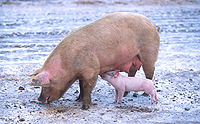
Wild
FeralPigs in culture Iron Age pig • Miss Piggy • Porky Pig • "The Three Little Pigs" • Babe • Charlotte's Web • The Sheep-PigCultural references to pigs Meat Poultry/Game 

Livestock Beef and Veal • Bison • Dog • Goat • Guinea pig • Horse • Lamb and mutton • Llama • Pork • Yak
Fish/Seafood Crab • Crayfish • Lobster • Prawn • Shrimp • Anchovy • Basa • Bass • Catfish • Carp • Cod • Crappie • Dolphin • Eel • Flounder • Grouper • Haddock • Halibut • Herring • Kingfish • Mackerel • Mahi Mahi • Marlin • Milkfish • Orange roughy • Perch • Pike • Pollock • Salmon • Sardine • Sole • Swordfish • Tilapia • Trout • Tuna • Walleye • Whale
Cuts / Preparation Other Butchery • Ethics • Preservation • Slaughter • Red meat • White meat
External links
- The Other White Meat Pork Main Website
- National Pork Board Pork Producer's Main Website
- National Pork Producers' Council
- Radio broadcast about pork production by Kootenay Co-op Radio
- Slovak Pork Slaughter and Traditional Sausage Making - article in English with detailed pictures of a Slovak family slaughtering a pig in 68 steps
Wikimedia Foundation. 2010.


